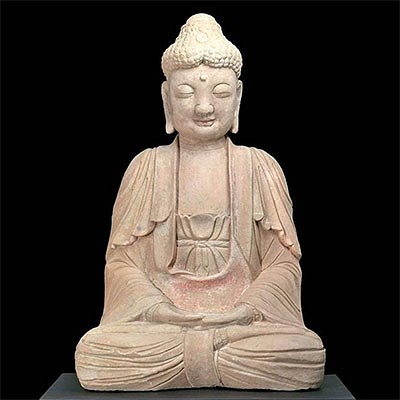Rare / Large Chavin Stone Flute Player
Lot 105c
About Seller
Artemis Gallery
686 S Taylor Ave, Ste 106
Louisville, CO 80027
United States
Selling antiquities, ancient and ethnographic art online since 1993, Artemis Gallery specializes in Classical Antiquities (Egyptian, Greek, Roman, Near Eastern), Asian, Pre-Columbian, African / Tribal / Oceanographic art. Our extensive inventory includes pottery, stone, metal, wood, glass and textil...Read more
Estimate:
$50,000 - $75,000
Absentee vs Live bid
Two ways to bid:
- Leave a max absentee bid and the platform will bid on your behalf up to your maximum bid during the live auction.
- Bid live during the auction and your bids will be submitted real-time to the auctioneer.
Bid Increments
| Price | Bid Increment |
|---|---|
| $0 | $25 |
| $300 | $50 |
| $1,000 | $100 |
| $2,000 | $250 |
| $5,000 | $500 |
| $10,000 | $1,000 |
| $20,000 | $2,500 |
| $50,000 | $5,000 |
| $100,000 | $10,000 |
| $200,000 | $20,000 |
About Auction
By Artemis Gallery
Feb 18, 2021
Set Reminder
2021-02-18 10:00:00
2021-02-18 10:00:00
America/New_York
Bidsquare
Bidsquare : Exceptional Antiquities, Asian, Ethnographic
https://www.bidsquare.com/auctions/artemis-gallery/exceptional-antiquities-asian-ethnographic-6373
Museum-worthy examples of Egyptian, Greek, Roman, Etruscan, Near Eastern, Far East / Asian, Pre-Columbian, African / Tribal, Oceanic, Native American, Spanish Colonial, Russian, Fossils, Ancient Jewelry, Fine Art, so much more! Artemis Gallery info@artemisgallery.com
Museum-worthy examples of Egyptian, Greek, Roman, Etruscan, Near Eastern, Far East / Asian, Pre-Columbian, African / Tribal, Oceanic, Native American, Spanish Colonial, Russian, Fossils, Ancient Jewelry, Fine Art, so much more! Artemis Gallery info@artemisgallery.com
- Lot Description
Pre-Columbian, Northern Peru, Chavin culture, ca. 1000 to 500 BCE. This is a rare and massive example of a hand-carved and stylized anthropomorphic figure holding a flute. The statue is made from a single piece of stone presenting beautiful beige and white hues. The man stands upon an integral base with legs bowed inward but toes pointed outward. The limbs are carved in relief, with the arms across the chest, and individual fingers are incised over the flute which is clutched beneath the rounded chin. The minimalist visage is very angular; exhibiting slit-form eyes and lips, a wide nose, and an incised forehead with a short coiffure or headdress. The top of the head is flat and the verso of the statue is slightly convex but free of carvings. A wonderful depiction! Size: 9.25" L x 4.5" W x 22" H (23.5 cm x 11.4 cm x 55.9 cm); 23" H (58.4 cm) on included custom stand.
The Chavin people lived in the northern Highland Andes, and their capital, Chavin de Huantar, is a UNESCO World Heritage Site. The artwork of Chavin represents the first widespread artistic style in the Andes. The center of Chavin de Huantar is a massive, flat-topped pyramid, surrounded by lower platforms. Between 1200 and 500 BCE the pyramid space was used for religious ceremonies. The Old Temple, constructed very early in the history of the site, consists of a series of passageways built around a circular courtyard; within were carved stone monuments showing jaguars, serpents, and other figures with transformative and/or anthropomorphic figures. A flute player may have been displayed at such a temple, for wind music held symbolic and cultural importance in Chavin society. Given the narrow shape of the eyes, this figure may have represented a shamanic individual who had entered a trance-like state. Such an altered consciousness could have been brought about by simply playing the music – along with a plethora of hallucinogenic materials – or in order to perform certain ceremonial songs which an unaltered state of mind could not begin to manifest.
Provenance: private Hawaii, USA collection; ex-private Hans Juergen Westermann collection, Germany, collected from 1950 to 1960s
All items legal to buy/sell under U.S. Statute covering cultural patrimony Code 2600, CHAPTER 14, and are guaranteed to be as described or your money back.
A Certificate of Authenticity will accompany all winning bids.
We ship worldwide and handle all shipping in-house for your convenience.
#162483Surface abrasions and some softening of details. Chips and losses to peripheries. Light mineral deposits. Rare form!Condition
- Shipping Info
-
All shipping is handled in-house for your convenience. Your invoice from Artemis Gallery will include shipping calculation instructions. If in doubt, please inquire BEFORE bidding for estimated shipping costs for individual items.
-
- Buyer's Premium



 EUR
EUR CAD
CAD AUD
AUD GBP
GBP MXN
MXN HKD
HKD CNY
CNY MYR
MYR SEK
SEK SGD
SGD CHF
CHF THB
THB














